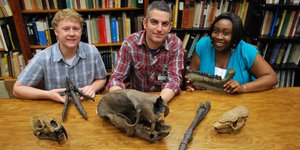by Chanika Symister and Sean Moran
Biomuseo is an exquisite structure designed by world renowned architect Frank Ghery. When this museum opens, it is expected to be one of Panama’s biggest tourism attractions. While this complex structure is still under construction, the museum has 4,000 square meters divided in seven hall exhibits that will portray Panama’s unique biodiversity. PCP-PIRE members are honored to be able to participate in the development of the exhibits by creating replicas of fossils that are intended to showcase past Panamanian diversity. PCP-PIRE will contribute to five specimen cases that will house interesting and beautiful fossils from Florida and Panama.

The casts range from the foot of the large Terror bird, Titanis, the skull of the saber-toothed cat, Smilodon to the carapace of the giant armadillo, Glyptodont. These replicas are made by first molding clay around the fossil. Silicon is used to construct the mold which is then filled with resin to cast. Once the resin has solidified, it is removed from the mold and prepared for painting. We use acrylic paints to mimic the colors seen on the real fossil so that our replicas can look as life-like as possible.
These casts will help achieve Biomuseo’s goal of becoming a global center of attraction for the exploration, knowledge and protection of biodiversity and will inevitably educate the nation of their natural history.
AUTHOR2
El Biomuseo es una distinguida estructura diseñada por el mundialmente reconocido arquitecto Frank Ghery. Cuando este museo abra sus puertas, se espera que sea una de las grandes atracciones turísticas de Panamá. Esta compleja estructura que aún está en construcción, tiene 4,000 metros cuadrados divididos en siete exhibiciones que mostrarán la biodiversidad única de Panamá. Integrantes del PCP-PIRE están honrados de poder participar en el desarrollo de las exhibiciones creando replicas de fósiles, las cuales expondrán la diversidad de Panamá en el pasado. El PCP-PIRE contribuirá con cinco cajones de especímenes que albergarán interesantes y hermosos fósiles de Florida y Panamá.

Las réplicas variarán desde el pie de un ave del terror, Titanis, el cráneo de un dientes de sable, Smilodon hasta el caparazón de un armadillo gigante, Glyptodont. Para hacer estas réplicas, se forma primero un molde de arcilla alrededor del fósil. Luego se usa silicona para construir el molde, el cual se llena de resina. Una vez la resina se solidifica, se remueve del molde y se prepara para pintar. Usamos pintura acrílica para imitar los colores del fósil real, de modo que nuestras réplicas luzcan tan parecidas a las verdaderas como sea posible.
Estas réplicas ayudaran a lograr la meta del Biomuseo de convertirse en un centro de atracción global para la exploración, conocimiento y protección de la biodiversidad e inevitablemente educará a la nación sobre su historia natural.